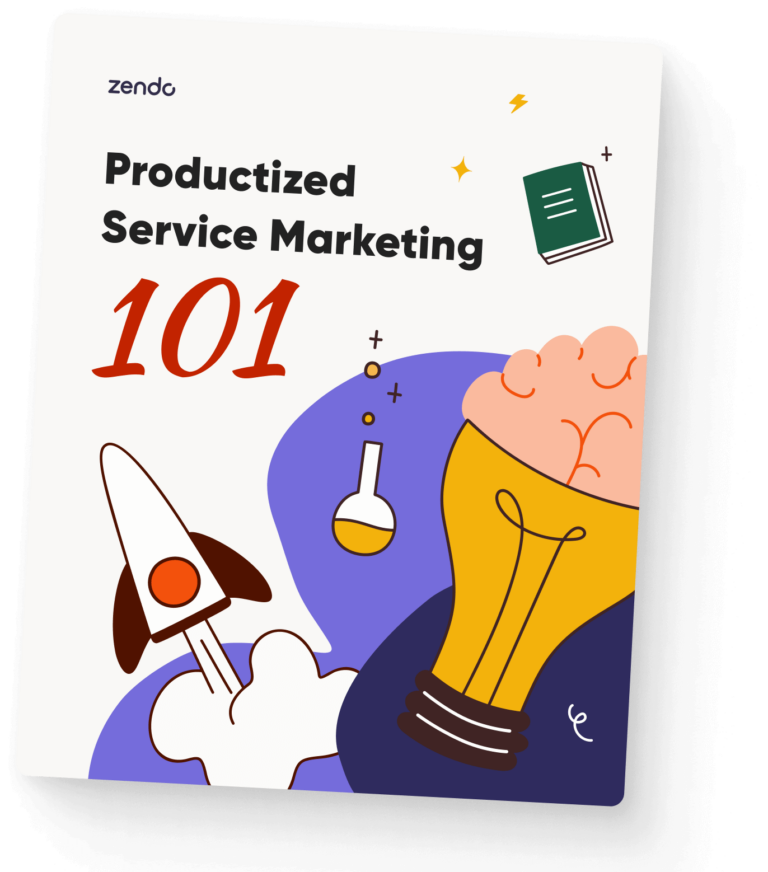The productized services model is still shrouded in mystery as we figure out this shift in the service industry.
As much as you can barely find a definition of ‘productize’ in any dictionary.
The best you’ll found in online dictionaries is in the Macmillan Dictionary that gives a simple enough definition of ‘productize’:
to make an idea, a service or an item into a product that can be sold
And a productized services model for business is just that. Making sure that your services are predefined, have set prices, and can be purchased by clients just like cereal from the grocery store.
But before you rush to change your services into products, stop for a moment and read more about this business model.
What are its pros and cons, what are the specific ways to productize your services, and how are the seller’s and buyer’s perspective different to get a clear picture and figure out whether or not it fits your specific business and clients.
Let’s jump in!
The Road to Productized Services
To understand productized services and that business model in general, we have to briefly mention the service industry first.
The early beginnings of the service industry came right with the new century. But as we can find in the Rise of the Service Economy written by Robert Millward and published online by the Cambridge University Press, the significant rise in that industry came just at the end of the 20th century.
And so we were introduced to hairdressers, barbers, professional services, legal and health care, plumbers, cleaning services, or even cinema. The service industry thrived and evolved with every step of the way.
But right from the beginning, it was services that were the most intangible of goods customers would get in exchange of their money. You could simply be paying for someone’s time or expertise – leaving empty handed, but richer in knowledge or with an action plan to deal with your problems.
Then with the digitalization and Internet came even more confusion. Customers now have access to online stores, legal services, marketing services, and so much more without ever having to leave their homes.
In turn, such accessibility brought a wide range of customization, which at the beginning was the best perk of the service industry, but then came back to bite it. Too much customization led to service-based businesses hitting a wall. After all, you can provide so many custom services in one week.
And that is the point when productized services came into the picture.
First Mentions of Productized Services
First mentions of productized services in books came surprisingly early, even 1989, but the way they defined productization of services back then was a bit different from the way we’re seeing it now.
To give you an example, here’s an excerpt from Readings in Managerial Psychology book written in 1989 that includes a definition of productization of services:
This is the process of analyzing the needs of present and potential customers in order to design the products and/or services that will satisfy their needs.
Managing Business Marketing & Sales: An International Perspective from 2005 gives the following insight on what productization may be:
Usable features, it is held, delivered in a well-balanced package, are the heart of productization. Similarly, intangible services can be made more tangible, and therefore more understandable, if augmented by documentation, evidence of previous success, etc.
Right now, we simply see it as offering standardized services with a clear scope and predefined price included.
But the author of Managing Business Marketing & Sales is right that productization makes in fact intangible services feel more tangible and transparent to the client.
The Rising Popularity of Productized Services
Right now, the productized services model is the new talk in town.
Everyone wants to productize their services and switch to this business model hoping for more scalability and increased customer satisfaction.
But as with every big change in the way you run your business, it has to be carefully analyzed and planned out.
An important question to ask is are we blindsided by the productization bliss or do we fully understand this business model and its pros and cons?
Because, as everything, productization and its specific models, also have their downfalls.
Productized Services Model: Seller & Buyer’s Perspective
Before we get into the specific ways you can productize your services and the advantages/disadvantages of these solutions, let’s get an overview of the seller’s and buyer’s perspective on the productized services business model in general.
Seller’s Perspective on Productized Services
| 😊PROS | 😬CONS |
| Standardized Processes and Blueprints | May Be Time-Consuming |
| Easy Evaluation | May Need Investments |
| Easy Employee Training | Customer Relationships May Suffer |
| Scalability Opportunities | May Narrow Down the Client Base |
| Upfront Payments | |
| Sellers Don’t Have to Be Involved in the Selling Process | |
| Easier Upselling | |
| More Reliable Business |
Pros for Sellers
As a service-based business owner, you’ll get:
- Standardized processes: that require much less supervision and are easier to carry out because each service you’ll offer will be predefined. That means no more selling a totally differently customized service each time, having to bend over backwards while providing your solution.
- Services easier to evaluate and audit: with standardized processes also comes easier evaluation. You’ll now have a blueprint for selling your services that you can follow with each client.
- Less complicated employee training process: because services with a defined scope, price, and processes are a breeze to explain to new employees. You won’t have to dive into each case individually, explaining its complexity, but simply showcase what you have established as your productized services.
- Scalability opportunities: finally you can scale your service-based business because you will no longer be exchanging your time for money. Instead you’ll be giving out your expertise, knowledge, or an outlined result for money. You can work with multiple clients at once, you can sell a pre-prepared ebook or course, or get a limited number of predefined tasks done for customers as a weekly or monthly packaged service.
- Upfront payments: forget about advance payments, installments, or receiving clearance after finalizing the project. With productized services, your clients will pay for your services upfront, with no proposals or custom offers needed either.
- Easier sells: think of selling productized services like this: imagine your website as a grocery store and the services page as one big shelf in the store. You place your products on the shelf and your customers visit your store, look through the available products, and place them in their cart. If they are decided, they pay and wait for the expected results. And you don’t have to bother explaining each service, preparing proposals, hopping on calls, and doing the absolute most to get sales anymore.
- Easier upselling: create add-ons to your productized services and just give that option to your clients during the buying process. They can simply add the extra services to their cart and pay as they go.
- A more reliable business: being in the position where you no longer rely on one big project or one big client that can ghost you anytime makes a productized service business much more reliable, helping you calculate your costs and revenue more easily.
Cons for Sellers
But as a seller, you will have to take into consideration the following:
- not everyone will like the pre-defined options: pre-defined options may be unattractive to clients that prefer customization (so it may narrow down your client base).
- time and money investment needed: the switch to a new business model may be time consuming, stressful, and require some careful planning and investing.
- customer relationships may suffer: it may become more difficult to build relationships with clients, especially long and fruitful ones. You will no longer be as involved in the sales process as you were selling custom services.
Buyer’s Perspective on Productized Services
| 😊PROS | 😬CONS |
| Transparency | May Feel Less Personalized |
| Predictability | Less Customization |
| Self-Service |
Pros for Buyers
For prospective clients the switch to productized service business is a bit more simple. They’ll get:
- more transparency: they know what they’re getting upfront. No fluff, no unnecessary calls and video chats with explanations. Everything is laid out in the productized service outline.
- more predictability: your customers will now know when to expect the results of your service (without having to speak to you!), know how much they are paying, and what exactly can they expect of the service they’re buying.
- self-service and quicker buying process: the self-service thing is not only easier for the seller but is also a blessing for the buyer. Because it’s not only entrepreneurs who value their time, it’s also customers. If they can purchase your service in a few clicks on your website without any prior consultations and they know what they’re getting at the same time, you can be sure they will appreciate that!
Cons for Buyers
In turn, customers may suffer from:
- less personalization: the experience of buying productized services may come as less personalized for the client, because they won’t have direct conversations with you or your team before purchase. Unless you take care of also adding such an option to your offer, e.g. in the form of a Book a Call button next to your productized service.
- less customization: productized services have a predefined and final scope, therefore, your customers won’t have as much freedom in granting their wishes for what the final service will include.
4 Productized Services Models with Pros and Cons
Let’s say you’ve now taken an insightful look at your business and decided that the pros of productization outweigh its cons.
Now it’s time to learn more about the different methods of service productization to know more on how this business model can be executed and which of the following ways of productization is best for you.
Option #1: The One-Time Model
Description
The one-time productized service model refers to a packaged service that’s sold for a fixed one-time fee. It does not require creating custom proposals, has a predefined scope of what the client is getting in exchange for their money, and ideally has a set delivery deadline.
Visualization
Walter is an SEO expert who started out in the business as a freelancer working through Fiverr. Over time, Walter built himself a knowledgeable SEO team and opened an agency.
Since Walter operated his business through Fiverr, he knew how well productized services work with potential clients and decided to copy that operation scheme into his off-Fiverr business.
His agency Simple SEO now offers a wide variety of one-time SEO services that can be easily purchased with a click of the button.
Therefore, one of the services Walter’s customers can purchase is a packaged service of a keyword gap analysis.

Pros and Cons of the One-Time Model
Pros
- easy to transform your most-often sold services into one-time packages
- easy to sell with self-service and upsell with add-ons
- easy to calculate the revenue because of the fixed price
- easy to pause taking on new orders once your capability has been reached
Cons
- it may be difficult to build customer relationships without personalization and customization
- the customer lifetime value may be low since you’ll have to constantly acquire new clients, of course you can avoid that, e.g. by sticking to a Value Ladder technique in your sales. Meaning that the one-time packages will serve as the bottom of the ladder and will incentivize your clients to purchase further services in your offer. Still, you have to take care of it on top of productizing.
Option #2: The Recurring Model
Description
The recurring productized services model is a service or a package of services offered for a flat monthly fee, therefore, subscription based.
Visualization
Gustavo is a graphic design and content service provider, specializing particularly in UX and UI.
Gustavo is also a solopreneur, managing the business all by himself, which makes time the most valuable to him.
He came up with a package of services he can offer for a flat monthly fee to all potential customers and that turned out to work great!
Why? Because Gustavo gained the time he wasted preparing individual custom proposals, hopping on calls with clients, and creating and sending estimations.
Gustavo can now spend this time working on more projects and plan his work more efficiently since he knows exactly what will need to get done thanks to the now standardized process and the detailed scope of the service.
Gustavo’s offer now includes a monthly graphic design and content care package.

Pros and Cons of the Recurring Model
Pros
- recurring revenue: a more stable revenue than one-time payments is granted in this business model
- it’s possible and even encouraged to build customer relationships to retain customers
- a clear scope of the service helps planning out your work ahead of time
Cons
- prepare to fight the churn
Option #3: The Unlimited Tasks Subscription Model
Description
A different approach to subscriptions, the unlimited tasks subscription productized service model is an offer of completing small tasks, usually relating to maintenance, for a flat monthly fee.
Visualization
Jesse built several SquareSpace websites and knows the exact nuts and bolts of this system.
Knowing this, Jesse decided to take advantage of his expertise and now helps other people with SquareSpace, offering website maintenance for a flat rate monthly fee.
Jesse’s customers love having an expert taking care of their website and knowing exactly how much they need to pay for that maintenance.

Pros and Cons of the Unlimited Tasks Model
Pros
- a stable revenue (MRR)
- customers may purchase the subscription even though their list of small tasks to get done is short
- customers may keep their subscription even without any pending tasks
- small tasks can get done quickly
- you can limit the number of active tasks/requests not to overwhelm your team with the amount of work and make this business model predictable
Cons
- your clients may have concerns as to the time needed to complete the tasks they have assigned. Hence, it will be crucial to ensure your customers that you’re taking your due diligence in completing the assigned tasks in a timely manner and are not unnecessarily prolonging the time needed to get them done.
- as always with recurring models – expect to fight the churn
Option #4: The Done-with-You Model
Description
The done-with-you productized service business model relies on sharing your knowledge, expertise, or blueprints with customers in order to teach them to complete tasks or strategies themselves later on. Most often, these are various coaching or productized consulting services.
Visualization
Saul is a Google Ads specialist and besides just setting up ad campaigns for his clients, he is also eager to share his knowledge with others.
So he created a 1:1 Google Ads consultation package.

Pros and Cons of the Done-with-You Model
Pros
- Because you’re sharing your knowledge and expertise and expect the client to use it later on without you (as opposed to a done-for-you service), done-with-you services can be more high-ticket ones
- You can scale such service by offering one-to-many instead of one-to-one consultations and still successfully share your expertise while gaining a multiplied revenue at the same time
Cons
- Done-with-you services will most likely be one-time services, so no MRR once your client learns how to do the things you do
Now that we know more on the genesis of productized services, have the pros and cons in mind, and do realize how different productization methods work, let’s summarize this article in a few words by answering the following quesion.
Is Productization the Future of Service Business?
Numerous online businesses, agency owners, freelancers, solopreneurs, and entrepreneurs find productized services worth their attention.
We think that the service industry is at the point of change and the switch to productized services is the way many business owners will take while on the split road.
To recap, productization gives you more time on your hands, more customers, more scalability, more money, and gives your customers more transparency and quicker and simpler buying process.
And if you’re still unsure as to which productized services model should you choose for your business, check out a list of real-life productized service examples we’ve crafted to get you the full picture of the productized services currently available on the market.
Of course, it’s also crucial to remember that building a successful productized service business takes time, effort, and meticulous planning. So don’t get blinded by the bliss and empty promises, think the switch through and do it the smart way.

A free online training. Delivered daily to your inbox to grow your productized agency.











